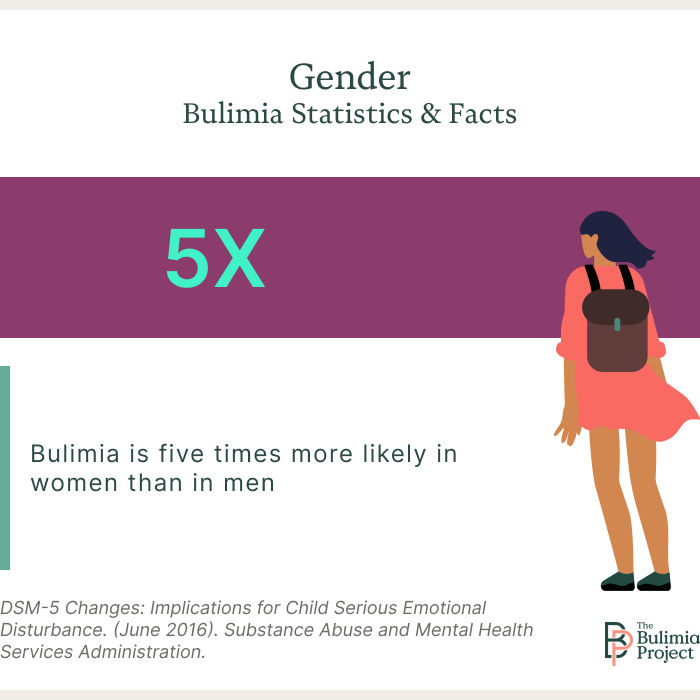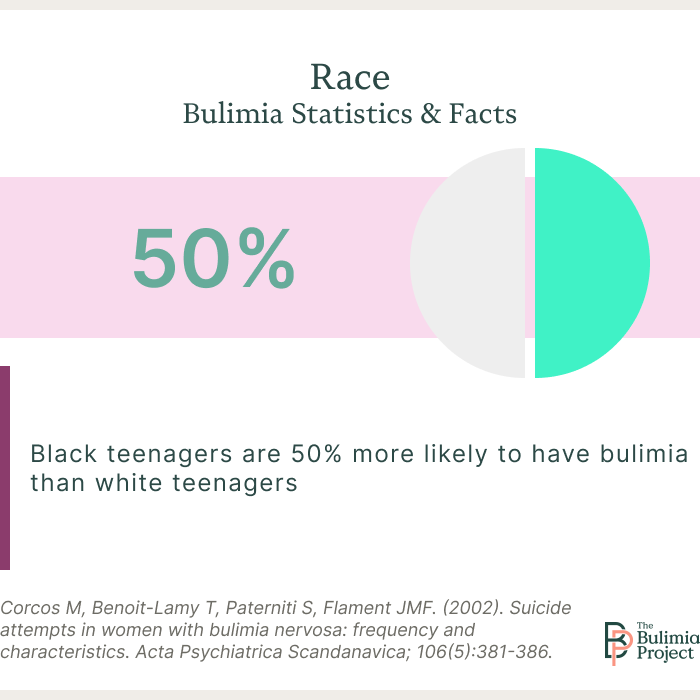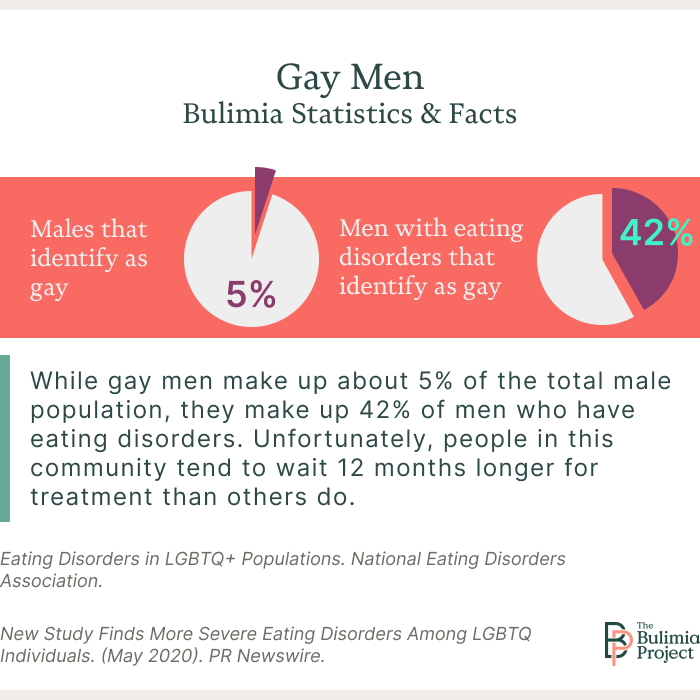
Statistics could be to blame. For years, we’ve been told that people with bulimia are almost exclusively female, white, wealthy, and straight. If someone who doesn’t fit this profile has bulimia symptoms, do they get diagnosed properly? And do they get treatment?
Let’s dig into the bulimia statistics so we can start to understand this eating disorder.
Bulimia, Sex, and Gender
Researchers say bulimia is five times more likely in women than in men. But this statistic could obscure the very real risks men face. (1)
A woman with bulimia is likely to talk about using a binge to cope with outside stress, and she purges because she wants to get or stay thin. A man with bulimia could look very different.
Men with eating disorders often express a wish to get big, bulky muscles and a very thin waist. They want to look like supermodels or weightlifters, and they’re willing to do almost anything to change their bodies accordingly.
A man like this may not seem fixated on losing weight. Instead, he might want to gain weight. But he might also purge to ensure the “wrong” calories don’t settle around his middle. (2)
His bingeing and purging cycles are real. But it’s likely to be misdiagnosed as something other than bulimia.

Bulimia and Race or Ethnicity
Black teenagers are 50% more likely to have bulimia than white teenagers. In fact, researchers say bulimia is more common in all minority groups than in white populations, contrary to popular belief.
Black teenagers are 50% more likely to have bulimia than white teenagers.

Black, Hispanic, and other so-called “minority” populations regularly face prejudice, discrimination, and hostility. Their lives are often filled with stress that outsiders can’t always understand. And the sources of their stress can’t be fixed by anything they might try as individuals. (3)
Bulimia can easily develop when people feel stressed and unable to fix situations in life. It’s often a method to gain control in a world that feels uncontrollable. It’s easy to see why people in minority populations face added risks.
People in minority populations also face many of the same risk factors that their white counterparts do. They are also, for example, forced to live in a society that prioritizes physical beauty. And they’re encouraged to push feelings down instead of discussing them. (4)
All of these factors can combine to increase the likelihood of a person dealing with bulimia.
Bulimia and Socioeconomic Class
Researchers can’t find a clear, common thread between household income and eating disorder risk. Anyone of any income could develop bulimia. (5)
But experts know that a life filled with stress can lead to bulimia, especially when that stress is impossible to amend. Relentless poverty is enough to make anyone search for what seems like a solution, and like all eating disorders, bulimia can give people a sense of control.
When compared to people working full-time, those not working due to disabilities are more likely to have bulimia, researchers say. Unfortunately, they may not have the resources needed to enroll in treatment. As a result, their eating disorder may go untreated for longer. (6)
Bulimia and LGBTQ Status
Every person in the LGBTQ community is an individual, and eating disorder rates vary widely from group to group. But one statistic makes the scope of the problem clear.
While gay men make up about 5% of the total male population, they make up 42% of men who have eating disorders. It’s clear that people in the LGBTQ community face more bulimia risks than others do. (7)

Unfortunately, people in this community tend to wait 12 months longer for treatment than others do. These delays allow eating disorders to worsen, and they could complicate recovery too. (8)
Those in the LGBTQ community tend to wait 12 months longer for treatment.
Once they do get into treatment, care is less likely to be customized for people in the LGTBQ community. Programs that cater to this demographic are few and far between, and it’s important to have a treatment program that is customized to the individual.
Final Thoughts on Bulimia Statistics and Facts
Understanding who has bulimia is important. When you see the data, you can assess your overall risk.
But remember that you’re an individual. If you don’t see yourself in these facts and figures despite the fact that you have real bulimia struggles, you can still get help. Bulimia is treatable.
Many treatment centers offer comprehensive care for bulimia. With medical supervision, personalized therapy plans, and continual support, you’ll be able to effectively manage your eating disorder.
Bulimia doesn’t have to hold you back from the life you want. Take the first step to a healthier future today.
Resources
- Eating Disorders. National Institute of Mental Health.
- Males Don’t Present Like Females With Eating Disorders. National Eating Disorders Association.
- People of Color and Eating Disorders. National Eating Disorders Association.
- Ethnic Differences in Eating Disorder Prevalence, Risk Factors, and Predictive Risk Factors Among Young Women. (November 2018). Eating Behaviors.
- Diseases of Affluence? A Systematic Review of the Literature on Socioeconomic Diversity in Eating Disorders. (December 2021). Eating Behaviors.
- Socioeconomic Correlates of Eating Disorder Symptoms in an Australian Population-Based Sample. (January 2017). PLOS One.
- Eating Disorders in LGBTQ+ Populations. National Eating Disorders Association.
- New Study Finds More Severe Eating Disorders Among LGBTQ Individuals. (May 2020). PR Newswire.